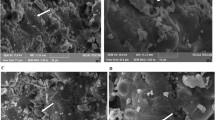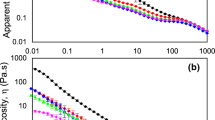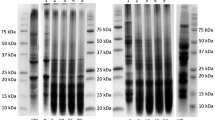Abstract
This study aimed to investigate the suitability of lentil protein and emulsions thereof for the formulation of a milk substitute. The effect of high-pressure homogenisation and heat treatments on functional and physico-chemical properties of lentil protein solutions (3.3% w/w) and the emulsions, containing fat contents similar to commercial cow’s milk, was studied. Dynamic high-pressure treatments of 180 and 900 bar greatly affected physical and structural properties of the lentil proteins: the particle size was reduced by 100-fold to 129.00 nm for samples homogenised at 900 bar, leading to an almost complete solubilisation. Surface properties of lentil protein changed, as shown in an increase of hydrophobicity and decrease of free sulfhydryl groups, while changes in secondary structure and aggregation did not develop. Little impact was observed of the heat-treatment at 65 or 85 °C, however, colour changed from a faint pink hue to be more white in appearance. The obtained emulsions exhibited good colloidal stability at both homogenisation pressures, while overall product quality was best when treated at 900 bar. Sensory analyses showed the formulated lentil-based milk substitute had textural and organoleptic profiles comparable to commercial plant-based milk substitutes, including soya-based products. Lentil protein isolates showed great potential to be used formulating milk substitutes with a high-protein content, similar to cow’s milk.





Similar content being viewed by others
References
FAO (2013) Milk and dairy products in human nutrition, 1st edn. FAO, Rome
Mintel Group Ltd. (2018) US non-dairy milk sales grow 61% over the last 5 years|Mintel.com. http://www.mintel.com/press-centre/food-and-drink/us-non-dairy-milk-sales-grow-61-over-the-last-five-years. Accessed 17 Aug 2018
Mintel Group Ltd. (2018) Taste is top reason Americans eat plant-based proteins|Mintel.com. http://www.mintel.com/press-centre/food-and-drink/taste-is-the-top-reason-us-consumers-eat-plant-based-proteins. Accessed 17 Aug 2018
Aleksandrowicz L, Green R, Joy EJM et al (2016) The impacts of dietary change on greenhouse gas emissions, land use, water use, and health: a systematic review. PLoS One. https://doi.org/10.1371/journal.pone.0165797
Vanga SK, Raghavan V (2018) How well do plant based alternatives fare nutritionally compared to cow’s milk? J Food Sci Technol 55:10–20. https://doi.org/10.1007/s13197-017-2915-y
Jeske S, Zannini E, Arendt EK (2017) Evaluation of physicochemical and glycaemic properties of commercial plant-based milk substitutes. Plant Foods Hum Nutr 72:26–33. https://doi.org/10.1007/s11130-016-0583-0
Sousa A, Kopf-Bolanz KA, Kopf-Bolanz K (2017) Nutritional implications of an increasing consumption of non-dairy plant-based beverages instead of cow’s milk in Switzerland. Adv Dairy Res. https://doi.org/10.4172/2329-888X.1000197
Riaz MN (2006) Processing of Soybeans into Ingredients. In: Riaz MN (ed) Soy application in food, 1st edn. Taylor & Francis Group, Boca Raton
Nadathur SR, Wanasundra JPD, Scanlin L (2017) Sustainable protein sources, 1st edn. Academic Press, London
Joshi M, Timilsena Y, Adhikari B (2017) Global production, processing and utilization of lentil: a review. J Integr Agric 16:2898–2913. https://doi.org/10.1016/S2095-3119(17)61793-3
Jarpa-Parra M (2018) Lentil protein: a review of functional properties and food application. An overview of lentil protein functionality. Int J Food Sci Technol 53:892–903. https://doi.org/10.1111/ijfs.13685
Ma Z, Boye JI, Simpson BK (2016) Preparation of salad dressing emulsions using lentil, chickpea and pea protein isolates: a response surface methodology study. J Food Qual 39:274–291. https://doi.org/10.1111/jfq.12190
Joshi M, Adhikari B, Aldred P et al (2012) Interfacial and emulsifying properties of lentil protein isolate. Food Chem 134:1343–1353. https://doi.org/10.1016/j.foodchem.2012.03.029
Johnston SP, Nickerson MT, Low NH (2015) The physicochemical properties of legume protein isolates and their ability to stabilize oil-in-water emulsions with and without genipin. J Food Sci Technol 52:4135–4145. https://doi.org/10.1007/s13197-014-1523-3
Dickinson E (1994) Protein-stabilized emulsions. Water in Foods 1:59–74
Kinsella JE (1982) Relationships between structure and functional properties of food proteins. In: Fox PF, Condon JJ (eds) food proteins. Applied Science Publishers, London
Bader S, Bez J, Eisner P (2011) Can protein functionalities be enhanced by high-pressure homogenization?—a study on functional properties of lupin proteins. Proced Food Sci 1:1359–1366. https://doi.org/10.1016/J.PROFOO.2011.09.201
Bouaouina H, Desrumaux A, Loisel C, Legrand J (2006) Functional properties of whey proteins as affected by dynamic high-pressure treatment. Int Dairy J 16:275–284. https://doi.org/10.1016/j.idairyj.2005.05.004
Dickinson E, Miller R (2001) Food colloids, fundamentals of formulation. The Royal Society of Chemistry, Cambridge
Primozic M, Duchek A, Nickerson M, Ghosh S (2017) Effect of lentil proteins isolate concentration on the formation, stability and rheological behavior of oil-in-water nanoemulsions. Food Chem 237:65–74. https://doi.org/10.1016/J.FOODCHEM.2017.05.079
Primozic M, Duchek A, Nickerson M, Ghosh S (2018) Formation, stability and in vitro digestibility of nanoemulsions stabilized by high-pressure homogenized lentil proteins isolate. Food Hydrocoll 77:126–141. https://doi.org/10.1016/j.foodhyd.2017.09.028
Can KA, Nickerson MT, Low NH (2011) Lentil and chickpea protein-stabilized emulsions: optimization of emulsion formulation. J Agric Food Chem 59:13203–13211. https://doi.org/10.1021/jf203028n
Jacobs D, Stephany M, Eisner P, Toestede S (2016) Sensory quality of lupin protein based milk alternatives. Agro Food Ind Hi Tech 27:XII–XV
Hayakawa SS, Nakai S (1985) Relationships of hydrophobicity and net charge to the solubility of milk and soy proteins. J Food Eng 50:486–491. https://doi.org/10.1111/j.1365-2621.1985.tb13433.x
Van der Plancken I, Van Loey A, Hendrickx MEG (2005) Changes in sulfhydryl content of egg white proteins due to heat and pressure treatment. J Agric Food Chem 53:5726–5733. https://doi.org/10.1021/jf050289+
International Dairy Federation (1995) 173:1995 Dried milk protein products—determination of nitrogen solubility index. International Dairy Federation, Brussels
Greenfield N (2007) Using circular dichroism spectra to estimate protein secondary structure. Nat Protoc 1:2876–2890. https://doi.org/10.1038/nprot.2006.202
Ryan M, McEvoy E, Duignan S et al (2008) Thermal stability of soy protein isolate and hydrolysate ingredients. Food Chem 108:503–510. https://doi.org/10.1016/j.foodchem.2007.11.001
Auty MAE, Twomey M, Guinee TP, Mulvihill DM (2018) Development and application of confocal scanning laser microscopy methods for studying the distribution of fat and protein in selected dairy products. J Dairy Res 68:417–427. https://doi.org/10.1017/S0022029901004873
Bernat N, Cháfer M, Rodríguez-García J et al (2015) Effect of high pressure homogenisation and heat treatment on physical properties and stability of almond and hazelnut milks. LWT Food Sci Technol 62:488–496. https://doi.org/10.1016/j.lwt.2014.10.045
Stone H, Bleibaum RN, Thomas HA (2012) Sensory evaluation practices. Academic Press, London
Beverung CJ, Radke CJ, Blanch HW (1999) Protein adsorption at the oil/water interface: characterization of adsorption kinetics by dynamic interfacial tension measurements. Biophys Chem 81:59–80. https://doi.org/10.1016/S0301-4622(99)00082-4
Saio K, Kajikawa M, Watanabe T (1971) Food processing characteristics of soybean proteins. Agric Biol Chem 35:890–898. https://doi.org/10.1080/00021369.1971.10860005
Berghout JAM, Boom RM, van der Goot AJ (2015) Understanding the differences in gelling properties between lupin protein isolate and soy protein isolate. Food Hydrocoll 43:465–472. https://doi.org/10.1016/j.foodhyd.2014.07.003
Dickinson E (1986) Mixed proteinaceous emulsifiers: review of competitive protein adsorption and the relationship to food colloid stabilization. Top Catal 1:3–23. https://doi.org/10.1016/S0268-005X(86)80003-0
Aryee ANA, Boye JI (2015) Comparative study of the effects of processing on the nutritional, physicochemical and functional properties of lentil. J Food Process Preserv. https://doi.org/10.1111/jfpp.12824
Sathe SK, Zaffran VD, Gupta S, Li T (2018) Protein solubilization. J Am Oil Chem Soc 95:883–901. https://doi.org/10.1002/aocs.12058
Nakai S (1983) Structure–function relationships of food proteins with an emphasis on the importance of protein hydrophobicity. J Agric Food Chem 3:676–683. https://doi.org/10.1021/jf00118a001
Crowley SV, Megemont M, Gazi I et al (2014) Heat stability of reconstituted milk protein concentrate powders. Int Dairy J 37:104–110. https://doi.org/10.1016/J.IDAIRYJ.2014.03.005
Sadilova E, Carle R, Stintzing FC (2007) Thermal degradation of anthocyanins and its impact on color and in vitro antioxidant capacity. Mol Nutr Food Res 51:1461–1471. https://doi.org/10.1002/mnfr.200700179
European Parliament and Council of the European Union (2006) Regulation (EC) No 1924/2006 of the European Parliament and of the Council of 20 December 2006 on nutrition and health claims made on foods
Acknowledgements
The work for this publication has been undertaken as part of the PROTEIN2FOOD project. This project has received funding from the European Union’s Horizon 2020 research and innovation programme under grant agreement no. 635727. We thank our colleagues Martin Vogelsang O’Dwyer, Lilit Ispiryan and Michael Cronin for technical assistance, and James A. O’Mahony, Martina Hickisch and Dave Waldron, who provided insight and expertise that greatly assisted the work.
Author information
Authors and Affiliations
Corresponding author
Ethics declarations
Conflict of interest
The authors declare that they have no conflict of interest.
Compliance with ethics requirements
This article does not contain any studies with animal subjects or humans, besides the sensory evaluation.
Additional information
Publisher's Note
Springer Nature remains neutral with regard to jurisdictional claims in published maps and institutional affiliations.
Rights and permissions
About this article
Cite this article
Jeske, S., Bez, J., Arendt, E.K. et al. Formation, stability, and sensory characteristics of a lentil-based milk substitute as affected by homogenisation and pasteurisation. Eur Food Res Technol 245, 1519–1531 (2019). https://doi.org/10.1007/s00217-019-03286-0
Received:
Revised:
Accepted:
Published:
Issue Date:
DOI: https://doi.org/10.1007/s00217-019-03286-0




